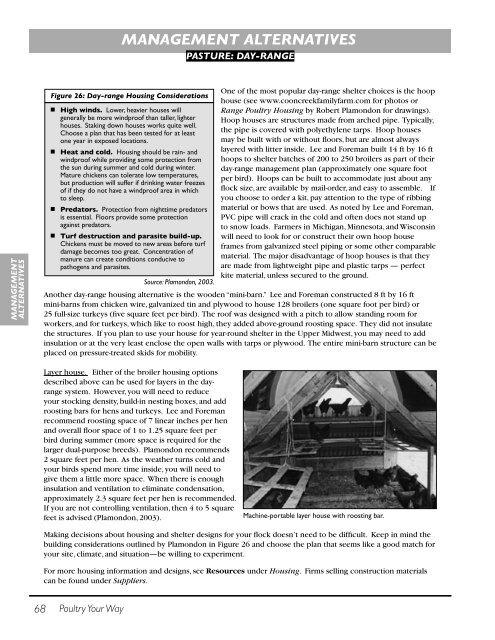Poultry Your Way - Center for Integrated Agricultural Systems ...
Poultry Your Way - Center for Integrated Agricultural Systems ...
Poultry Your Way - Center for Integrated Agricultural Systems ...
You also want an ePaper? Increase the reach of your titles
YUMPU automatically turns print PDFs into web optimized ePapers that Google loves.
MANAGEMENT<br />
ALTERNATIVES<br />
68<br />
<strong>Poultry</strong> <strong>Your</strong> <strong>Way</strong><br />
MANAGEMENT ALTERNATIVES<br />
PASTURE: DAY-RANGE<br />
Figure 26: Day-range Housing Considerations<br />
■ High winds. Lower, heavier houses will<br />
generally be more windproof than taller, lighter<br />
houses. Staking down houses works quite well.<br />
Choose a plan that has been tested <strong>for</strong> at least<br />
one year in exposed locations.<br />
■ Heat and cold. Housing should be rain- and<br />
windproof while providing some protection from<br />
the sun during summer and cold during winter.<br />
Mature chickens can tolerate low temperatures,<br />
but production will suffer if drinking water freezes<br />
of if they do not have a windproof area in which<br />
to sleep.<br />
■ Predators. Protection from nighttime predators<br />
is essential. Floors provide some protection<br />
against predators.<br />
■ Turf destruction and parasite build-up.<br />
Chickens must be moved to new areas be<strong>for</strong>e turf<br />
damage becomes too great. Concentration of<br />
manure can create conditions conducive to<br />
pathogens and parasites.<br />
Source: Plamondon, 2003.<br />
One of the most popular day-range shelter choices is the hoop<br />
house (see www.cooncreekfamilyfarm.com <strong>for</strong> photos or<br />
Range <strong>Poultry</strong> Housing by Robert Plamondon <strong>for</strong> drawings).<br />
Hoop houses are structures made from arched pipe. Typically,<br />
the pipe is covered with polyethylene tarps. Hoop houses<br />
may be built with or without floors, but are almost always<br />
layered with litter inside. Lee and Foreman built 14 ft by 16 ft<br />
hoops to shelter batches of 200 to 250 broilers as part of their<br />
day-range management plan (approximately one square foot<br />
per bird). Hoops can be built to accommodate just about any<br />
flock size, are available by mail-order, and easy to assemble. If<br />
you choose to order a kit, pay attention to the type of ribbing<br />
material or bows that are used. As noted by Lee and Foreman,<br />
PVC pipe will crack in the cold and often does not stand up<br />
to snow loads. Farmers in Michigan, Minnesota, and Wisconsin<br />
will need to look <strong>for</strong> or construct their own hoop house<br />
frames from galvanized steel piping or some other comparable<br />
material. The major disadvantage of hoop houses is that they<br />
are made from lightweight pipe and plastic tarps — perfect<br />
kite material, unless secured to the ground.<br />
Another day-range housing alternative is the wooden “mini-barn.” Lee and Foreman constructed 8 ft by 16 ft<br />
mini-barns from chicken wire, galvanized tin and plywood to house 128 broilers (one square foot per bird) or<br />
25 full-size turkeys (five square feet per bird). The roof was designed with a pitch to allow standing room <strong>for</strong><br />
workers, and <strong>for</strong> turkeys, which like to roost high, they added above-ground roosting space. They did not insulate<br />
the structures. If you plan to use your house <strong>for</strong> year-round shelter in the Upper Midwest, you may need to add<br />
insulation or at the very least enclose the open walls with tarps or plywood. The entire mini-barn structure can be<br />
placed on pressure-treated skids <strong>for</strong> mobility.<br />
Layer house. Either of the broiler housing options<br />
described above can be used <strong>for</strong> layers in the dayrange<br />
system. However, you will need to reduce<br />
your stocking density, build-in nesting boxes, and add<br />
roosting bars <strong>for</strong> hens and turkeys. Lee and Foreman<br />
recommend roosting space of 7 linear inches per hen<br />
and overall floor space of 1 to 1.25 square feet per<br />
bird during summer (more space is required <strong>for</strong> the<br />
larger dual-purpose breeds). Plamondon recommends<br />
2 square feet per hen. As the weather turns cold and<br />
your birds spend more time inside, you will need to<br />
give them a little more space. When there is enough<br />
insulation and ventilation to eliminate condensation,<br />
approximately 2.3 square feet per hen is recommended.<br />
If you are not controlling ventilation, then 4 to 5 square<br />
feet is advised (Plamondon, 2003).<br />
Machine-portable layer house with roosting bar.<br />
Making decisions about housing and shelter designs <strong>for</strong> your flock doesn’t need to be difficult. Keep in mind the<br />
building considerations outlined by Plamondon in Figure 26 and choose the plan that seems like a good match <strong>for</strong><br />
your site, climate, and situation—be willing to experiment.<br />
For more housing in<strong>for</strong>mation and designs, see Resources under Housing. Firms selling construction materials<br />
can be found under Suppliers.

















